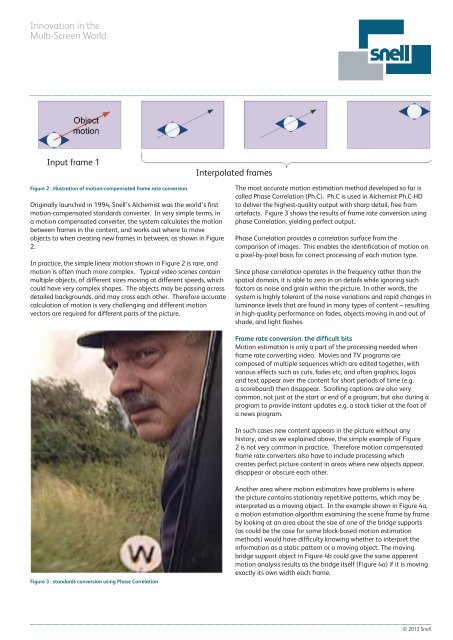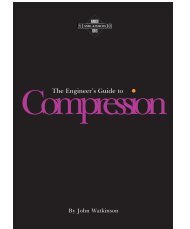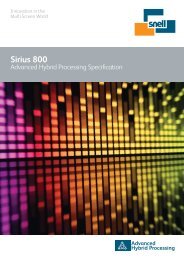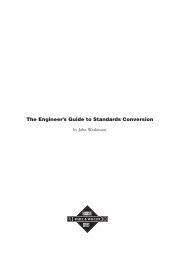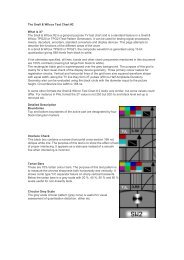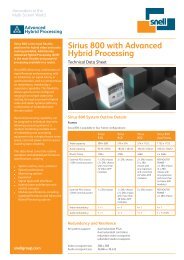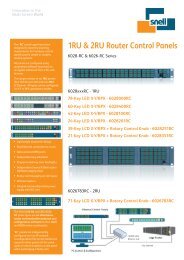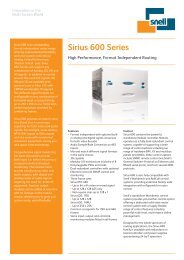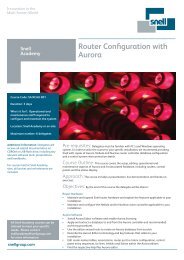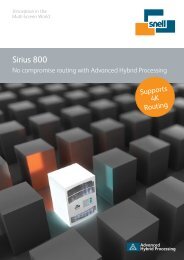Motion compensated frame rate conversion - White Paper - Snell
Motion compensated frame rate conversion - White Paper - Snell
Motion compensated frame rate conversion - White Paper - Snell
You also want an ePaper? Increase the reach of your titles
YUMPU automatically turns print PDFs into web optimized ePapers that Google loves.
Innovation in the<br />
Multi-Screen World<br />
Input <strong>frame</strong> 1<br />
Interpolated <strong>frame</strong>s<br />
Figure 2 : illustration of motion-<strong>compensated</strong> <strong>frame</strong> <strong>rate</strong> <strong>conversion</strong>.<br />
Originally launched in 1994, <strong>Snell</strong>’s Alchemist was the world’s first<br />
motion-<strong>compensated</strong> standards converter. In very simple terms, in<br />
a motion <strong>compensated</strong> converter, the system calculates the motion<br />
between <strong>frame</strong>s in the content, and works out where to move<br />
objects to when creating new <strong>frame</strong>s in between, as shown in Figure<br />
2.<br />
In practice, the simple linear motion shown in Figure 2 is rare, and<br />
motion is often much more complex. Typical video scenes contain<br />
multiple objects, of different sizes moving at different speeds, which<br />
could have very complex shapes. The objects may be passing across<br />
detailed backgrounds, and may cross each other. Therefore accu<strong>rate</strong><br />
calculation of motion is very challenging and different motion<br />
vectors are required for different parts of the picture.<br />
The most accu<strong>rate</strong> motion estimation method developed so far is<br />
called Phase Correlation (Ph.C). Ph.C is used in Alchemist Ph.C-HD<br />
to deliver the highest-quality output with sharp detail, free from<br />
artefacts. Figure 3 shows the results of <strong>frame</strong> <strong>rate</strong> <strong>conversion</strong> using<br />
phase Correlation, yielding perfect output.<br />
Phase Correlation provides a correlation surface from the<br />
comparison of images. This enables the identification of motion on<br />
a pixel-by-pixel basis for correct processing of each motion type.<br />
Since phase correlation ope<strong>rate</strong>s in the frequency rather than the<br />
spatial domain, it is able to zero in on details while ignoring such<br />
factors as noise and grain within the picture. In other words, the<br />
system is highly tolerant of the noise variations and rapid changes in<br />
luminance levels that are found in many types of content – resulting<br />
in high-quality performance on fades, objects moving in and out of<br />
shade, and light flashes.<br />
Frame <strong>rate</strong> <strong>conversion</strong>: the difficult bits<br />
<strong>Motion</strong> estimation is only a part of the processing needed when<br />
<strong>frame</strong> <strong>rate</strong> converting video. Movies and TV programs are<br />
composed of multiple sequences which are edited together, with<br />
various effects such as cuts, fades etc, and often graphics, logos<br />
and text appear over the content for short periods of time (e.g.<br />
a scoreboard) then disappear. Scrolling captions are also very<br />
common, not just at the start or end of a program, but also during a<br />
program to provide instant updates e.g. a stock ticker at the foot of<br />
a news program.<br />
In such cases new content appears in the picture without any<br />
history, and as we explained above, the simple example of Figure<br />
2 is not very common in practice. Therefore motion <strong>compensated</strong><br />
<strong>frame</strong> <strong>rate</strong> converters also have to include processing which<br />
creates perfect picture content in areas where new objects appear,<br />
disappear or obscure each other.<br />
Figure 3 : standards <strong>conversion</strong> using Phase Correlation<br />
Another area where motion estimators have problems is where<br />
the picture contains stationary repetitive patterns, which may be<br />
interpreted as a moving object. In the example shown in Figure 4a,<br />
a motion estimation algorithm examining the scene <strong>frame</strong> by <strong>frame</strong><br />
by looking at an area about the size of one of the bridge supports<br />
(as could be the case for some block-based motion estimation<br />
methods) would have difficulty knowing whether to interpret the<br />
information as a static pattern or a moving object. The moving<br />
bridge support object in Figure 4b could give the same apparent<br />
motion analysis results as the bridge itself (Figure 4a) if it is moving<br />
exactly its own width each <strong>frame</strong>.<br />
© 2013 <strong>Snell</strong>


